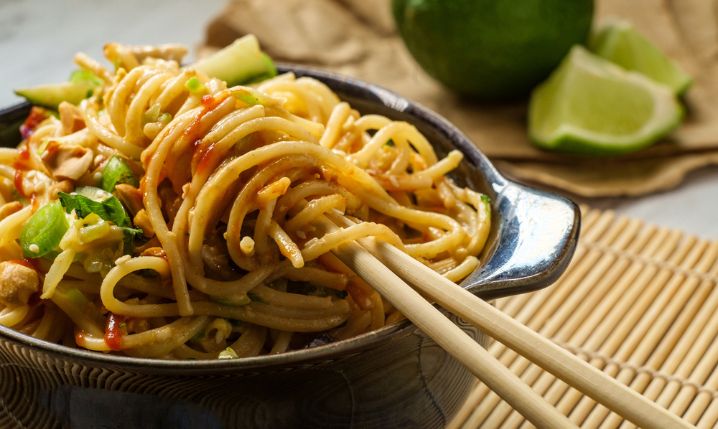There is such a wide variety of noodles to select from in an Asian supermarket. And it can be overwhelming for food lovers who’re not acquainted with them.
Another option is to just follow a recipe. In this case, you’d simply purchase and use the type of noodle it calls for.
However, what if you’re in the mood to switch things up? If so, you’ll need to understand the core variances when it comes to lo mein vs. rice noodles.
What are Lo Mein Noodles?
Wheat noodles like lo mein are pretty popular in China. They are cylindrical, like spaghetti, but a little thicker, about 1/4 of an inch thick. Eggs and wheat flour are their primary ingredients.
You’ll likely find fresh and dried lo mein at a specialty Asian grocery store. If not, chances are you’ll only find the dried variety at your local grocer.
To obtain the desired “bite” in fresh and dried forms, they must be briefly parboiled. For additional crispiness, the noodles can be stir-fried after parboiling. Or they can simply be served with meat and veggies and a sauce.
What are Rice Noodles?
The second big class of Asian noodles is the rice noodle. All around Asia, especially Southeast Asia, you’ll find rice noodles. They’re manufactured from rice starch in various lengths and widths.
They have a firm, springy structure that can absorb the tastes of the sauces or soups they’re served with. And even more so with thicker, broader variants.
Even though fresh rice noodles may be found in many Asian supermarkets, dried rice noodles are far easier to find. Soups and stir-fries typically incorporate rice noodles, which are prepared by soaking or parboiling before use.
While there is an extensive range in noodle width, most rice noodles are usually around 1/4 inch wide.
Lo Mein Vs. Rice Noodles: What’s the Difference?
Noodles can be divided into two distinct categories based on their ingredients.
Wheat flour is used to make lo mein noodles, while rice flour is used to make rice noodles. Lo mein noodles are often yellow or brown, whereas rice noodles are either yellow or white.
Additionally, lo mein noodles are often softer than rice noodles, which tend to have a chewy texture.
It can take up to 10 minutes for thicker lo mein noodles to cook on high heat. But it only takes 3 – 4 minutes on medium heat for thinner lo mein noodles to cook. Cooking rice noodles is usually a very quick process. But soaking them in boiling water for a few minutes is also an option.
Conclusion
Rice noodles have a naturally chewy feel. And they’re an excellent choice for gluten-free noodle options. However, lo mein noodles are a great choice if you’re thinking of making a crunchier noodle dish.
When you realize the difference between lo mein vs. rice noodles, you’re no longer restricted when creating the perfect noodle dish.
